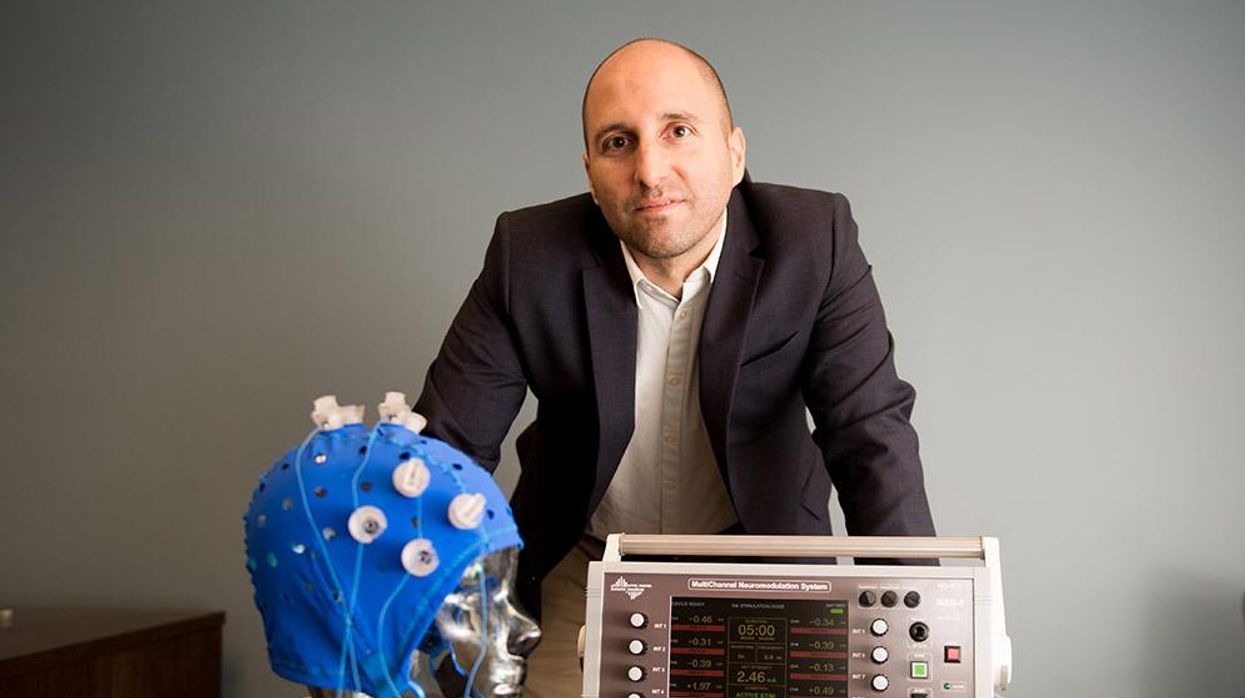Forget Farm-to-Table: Lab-to-Table Fresh Fish Is Making Waves
Kira Peikoff was the editor-in-chief of Leaps.org from 2017 to 2021. As a journalist, her work has appeared in The New York Times, Newsweek, Nautilus, Popular Mechanics, The New York Academy of Sciences, and other outlets. She is also the author of four suspense novels that explore controversial issues arising from scientific innovation: Living Proof, No Time to Die, Die Again Tomorrow, and Mother Knows Best. Peikoff holds a B.A. in Journalism from New York University and an M.S. in Bioethics from Columbia University. She lives in New Jersey with her husband and two young sons. Follow her on Twitter @KiraPeikoff.
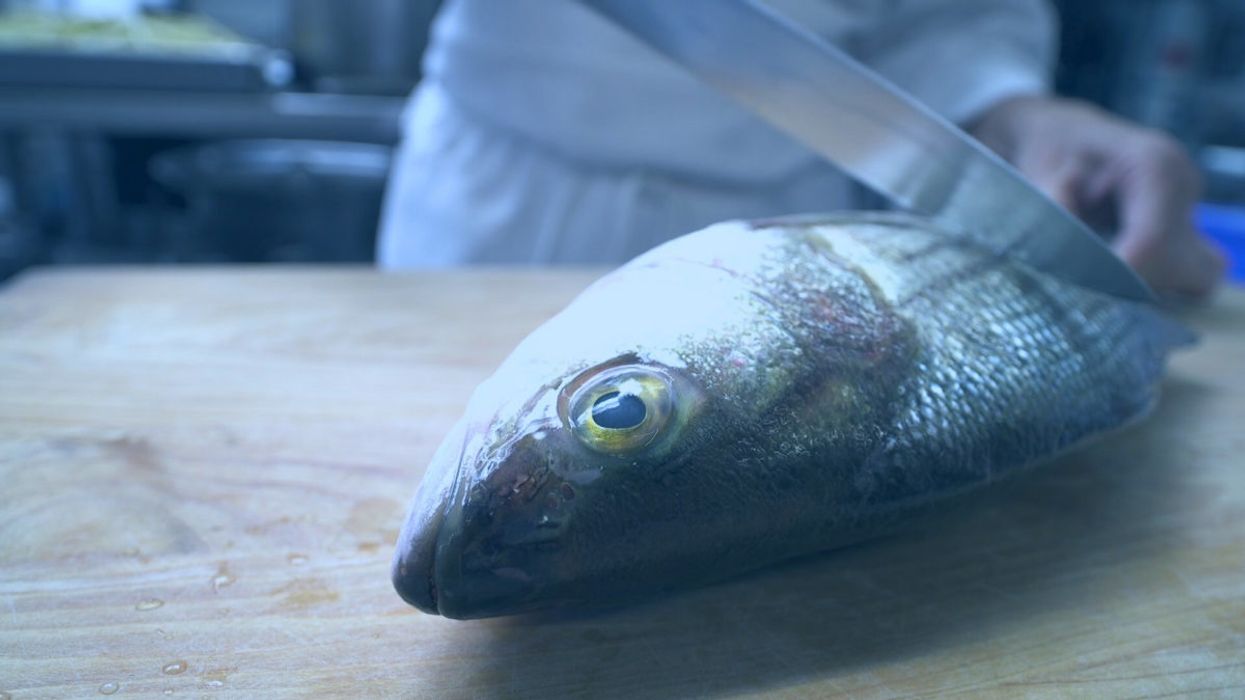
A conventionally sourced sea bass from a fishery.
Ever wonder why you've never heard of wild-caught organic fish? It's because there's no way to certify a food that has a mysterious history. Mike Selden, a 26-year-old biochemist with an animal lover's heart and an entrepreneur's mind, decided there must be better way to consume one of our planet's primary sources of animal protein. A way that would eliminate the need to kill billions of fish per year while also producing toxin-free, cheap, delicious fish meat for your dinner table. Enter Finless Foods, a young startup with a bold vision. Selden took time out of chauffeuring fish carcasses around San Francisco (no joke!) to share his journey with LeapsMag.
What is the biggest problem with the way fish is consumed today?
There are a lot of problems ranging from metals to animal welfare to human health. Technology is solving those problems at the same time. You've got extreme over fishing, which is collapsing ocean ecosystems and removing populations of fish that are traditionally used as food sources in developing nations.
In terms of animal welfare, fish are killed in massive numbers, billions a year. Even if people don't care too much about that, we want to give them another option.
In terms of health, which I think for most people is the most convincing argument, current fish have mercury and plastic in them. And if you're getting that fish from a farm, you will also have high levels of antibiotics and growth hormones if you're getting it from outside the U.S. What we're doing is producing fish that doesn't have any of those contaminants.
What gave you the idea to start a company around lab-grown fish?
I studied biochemistry and molecular biology at UMass Amherst, traditionally an agricultural school out in the woods of Massachusetts. I have always been an environmental activist and cared about animals. I thought, animal agriculture is so incredibly inefficient, what could be done to change it?
"The worst way you can possibly make a hamburger is with a cow."
Agriculture is a system of inputs and outputs, the inputs being feed and the outputs being meat – so why are we wasting all of this input on outputs we don't care about? Why are we creating these animals that waste all this energy through sitting around, moving around, having a heartbeat, blinking? All of this uses energy and that's valuable input.
The worst way you can possibly make a hamburger is with a cow. It's an awful transfer of energy: you have to feed it many times its own weight in food that could have fed other people or other things.
In February, I got funding from Indie Bio, a startup accelerator for synthetic biology, and moved out to San Francisco with my co-founder Brian Wyrwas. We started working in our lab in March. We're the newest company in the space.
Walk me through the process of creating edible fish in the lab. Do you have to catch a real live fish first and get their cells?
We have a deal with the Aquarium of the Bay, and whenever a fish dies, they call me, I get in a zip car, drive over, and bring the fish back to the lab, where Brian cultures it up into a cell culture. We do use real, high-quality fish stock. From there, we get the cells going in a bioreactor in a suspension culture, grow them into large quantities, and then bring them out to differentiate them into the cells people want to eat—the muscle and fat tissue. Then we formulate it and bring it to people's tables.
How long does the whole process take from the phone call about the fish dying to the food on the table?
There are two different processes: One is a research process, getting the initial cells and engineering them to be what we're looking for.
The other is a production process – we have a cell line ready and need to grow it out. That timing depends on how big of a facility we have. Since we're working with cell division: If you have 1 cell, in 24 hours, you'll have two cells. Let's say you have 1 ton of cells, in 24 hours you'll have two tons of cells.
"We want to give people the wholesome food they are used to in a healthier setting."
How are you looking to scale this process?
We're trying to find a middle ground between efficiency and local distribution. Organic farming is hilariously bad for the environment and horrifyingly inefficient, but on the other hand, industrial agriculture requires lots of transport, which is also bad for the environment. We're looking to create regionally distributed facilities which don't require a lot of transit, so people can have fresh fish even extremely far inland.
What kinds of fish are you "cooking"?
Our first product will be Bluefin tuna. It's a high-quality fish with high demand and it's also a conservation issue. We also currently have a culture going with Branzino, European sea bass, that we're really happy with.
There's a concept in science called a model organism – one that is extremely well studied and understood. Like the fruit fly, for example. For fish, it's the zebra fish, which is used for genetic research, but no one eats it. It's tiny, so we started by thinking: what fish do people eat that is also close evolutionarily to the zebra fish? We came up with carp, even though it's not too widely eaten.
But our process is very species agnostic. We've done work in trout, salmon, goldfish. Any fish with a dorsal fin works with our process. We tried a wolf eel but it didn't work. Eels are pretty far evolutionarily from fish, so we dropped that one.
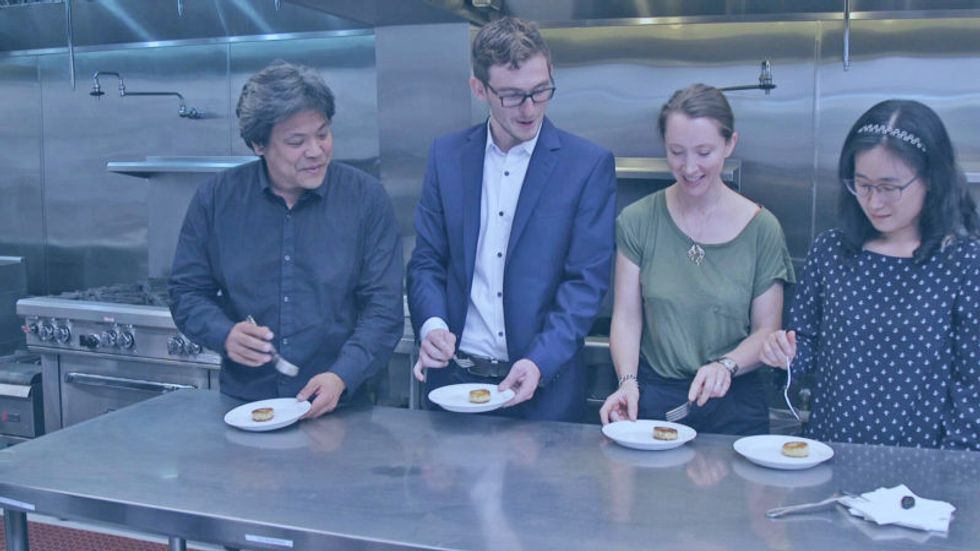
From left to right, Ron Shigeta (IndieBio), Brian Wyrwas (Finless Foods), Amy Fleming (The Guardian), and Jihyun Kim (Finless Foods) tasting the first ever clean carp croquettes.
(Courtesy Mike Selden)
Why fish as opposed to, say, a cow?
Scientifically, there are a lot of advantages. Fish have a simpler structure than land animals. A fillet from a cow has complex marbling going on between the fat and muscle. When it's fish, like sashimi, it's in layers of muscle and fat. So it's simpler to build, plus fish are cold-blooded, so because they breathe underwater, our equipment needs less complexity. We don't need a CO2 line and we don't need to culture our cells at 37 degrees Celsius. We culture them at room temperature.
It's also easier to get to market since there's much higher value. Chicken in the last year was $3.84 per pound in America, whereas Bluefin tuna is between $100 and $1200 a pound. Because this is about dropping cost, we can get to market faster and give investors a better value proposition.
What's also cool is that something like Bluefin tuna is something many people haven't had the opportunity to eat. We can get these down in cost until there is price parity with any cheap conventional fish. We want to give people a choice between buying something like albacore tuna in a can –with mercury and plastic– or high-quality tuna without any contaminants for the same price.
Do you shape them like fish fillets to help the consumer overcome whatever discomfort they might feel about eating a bunch of lab-grown cells?
Yeah, people want to continue eating food they are eating, and that's fine. We want to give people a better option. We don't want to give them something weird and out there. We want to give them the wholesome food they are used to in a healthier setting that also solves some environmental issues.
How about the taste? Have you done any blind side-by-side tests with the real thing and your version?
Not blind taste tests. But we have been tasting it, and it is firmly fish. I even tried leaving it outside of the fridge – and man, that tasted like spoiled fish.
We want it to have the exact same properties as real fish. We don't want people to have to learn how to cook with it. We want them to just bring it into their homes and eat it exactly like they were doing before, but better.
What you're growing isn't the whole fish, right? It is not an actual organism?
Right, we're only growing muscle cells. It doesn't know where it is. There is no brain, nervous system, or pain receptors.
Are you the only people in this lab-grown food space working on fish?
We're the only ones doing fish so far. Other companies are doing chicken, duck, egg white, milk, gelatin, leather, and beef.
Are people generally weirded out by sci-fi lab food, or intrigued?
It's been very positive. When people sit down and talk to us, they realize it's not some crazed money grab or some weird Ted talk, it's real activists using real science trying to solve real problems. Sure, there will be some pushback from people who don't understand it, and that's fine.
When can I expect to see Finless Food at my local Whole Foods?
We plan on being in restaurants in two years, and grocery stores in four years.
What about people who aren't big fans of fish in the first place? Like those who don't eat sushi, because consuming something raw with an unknown history isn't very appetizing.
There are too many examples of food poisoning because fish are in a less clean environment than they should be, swimming around in their own fecal matter, and being doused in antibiotics so their diseases don't transmit. It's a bit of a mess. That's why as an industry, we're calling this clean meat. Fish is a healthy thing, or at least it should be, with Omega 3 and 6, and DHA. This is a way for people to continue getting those nutrients without any of the questions of where it came from. For people who are skeptical of fish, we invite you to dive in.
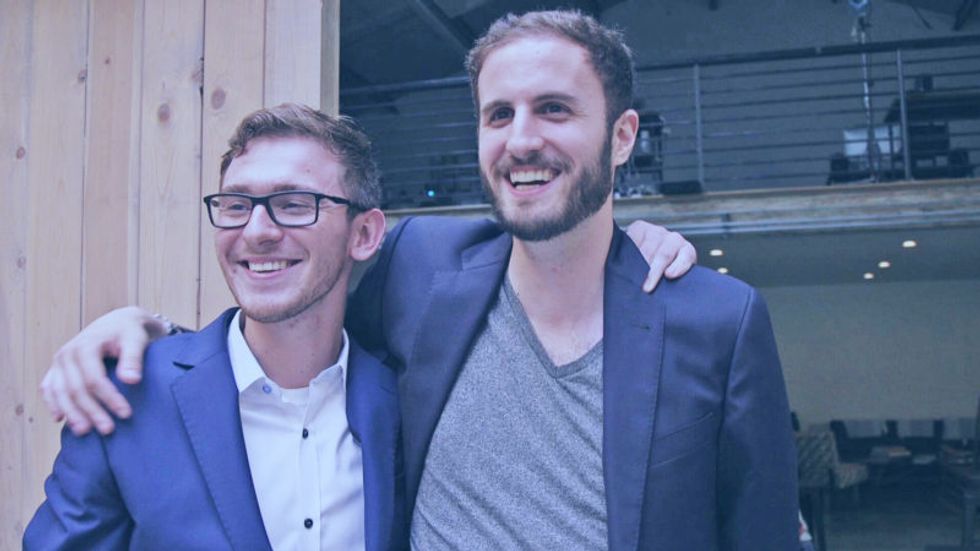
Brian Wyrwas, Co-Founder & CSO, and Mike Selden, Co-Founder & CEO
(Courtesy Mike Selden)
Kira Peikoff was the editor-in-chief of Leaps.org from 2017 to 2021. As a journalist, her work has appeared in The New York Times, Newsweek, Nautilus, Popular Mechanics, The New York Academy of Sciences, and other outlets. She is also the author of four suspense novels that explore controversial issues arising from scientific innovation: Living Proof, No Time to Die, Die Again Tomorrow, and Mother Knows Best. Peikoff holds a B.A. in Journalism from New York University and an M.S. in Bioethics from Columbia University. She lives in New Jersey with her husband and two young sons. Follow her on Twitter @KiraPeikoff.
The Friday Five: How to exercise for cancer prevention
How to exercise for cancer prevention. Plus, a device that brings relief to back pain, ingredients for reducing Alzheimer's risk, the world's oldest disease could make you young again, and more.
The Friday Five covers five stories in research that you may have missed this week. There are plenty of controversies and troubling ethical issues in science – and we get into many of them in our online magazine – but this news roundup focuses on scientific creativity and progress to give you a therapeutic dose of inspiration headed into the weekend.
Listen on Apple | Listen on Spotify | Listen on Stitcher | Listen on Amazon | Listen on Google
Here are the promising studies covered in this week's Friday Five:
- How to exercise for cancer prevention
- A device that brings relief to back pain
- Ingredients for reducing Alzheimer's risk
- Is the world's oldest disease the fountain of youth?
- Scared of crossing bridges? Your phone can help
New approach to brain health is sparking memories
This fall, Robert Reinhart of Boston University published a study finding that electrical stimulation can boost memory - and Reinhart was surprised to discover the effects lasted a full month.
What if a few painless electrical zaps to your brain could help you recall names, perform better on Wordle or even ward off dementia?
This is where neuroscientists are going in efforts to stave off age-related memory loss as well as Alzheimer’s disease. Medications have shown limited effectiveness in reversing or managing loss of brain function so far. But new studies suggest that firing up an aging neural network with electrical or magnetic current might keep brains spry as we age.
Welcome to non-invasive brain stimulation (NIBS). No surgery or anesthesia is required. One day, a jolt in the morning with your own battery-operated kit could replace your wake-up coffee.
Scientists believe brain circuits tend to uncouple as we age. Since brain neurons communicate by exchanging electrical impulses with each other, the breakdown of these links and associations could be what causes the “senior moment”—when you can’t remember the name of the movie you just watched.
In 2019, Boston University researchers led by Robert Reinhart, director of the Cognitive and Clinical Neuroscience Laboratory, showed that memory loss in healthy older adults is likely caused by these disconnected brain networks. When Reinhart and his team stimulated two key areas of the brain with mild electrical current, they were able to bring the brains of older adult subjects back into sync — enough so that their ability to remember small differences between two images matched that of much younger subjects for at least 50 minutes after the testing stopped.
Reinhart wowed the neuroscience community once again this fall. His newer study in Nature Neuroscience presented 150 healthy participants, ages 65 to 88, who were able to recall more words on a given list after 20 minutes of low-intensity electrical stimulation sessions over four consecutive days. This amounted to a 50 to 65 percent boost in their recall.
Even Reinhart was surprised to discover the enhanced performance of his subjects lasted a full month when they were tested again later. Those who benefited most were the participants who were the most forgetful at the start.
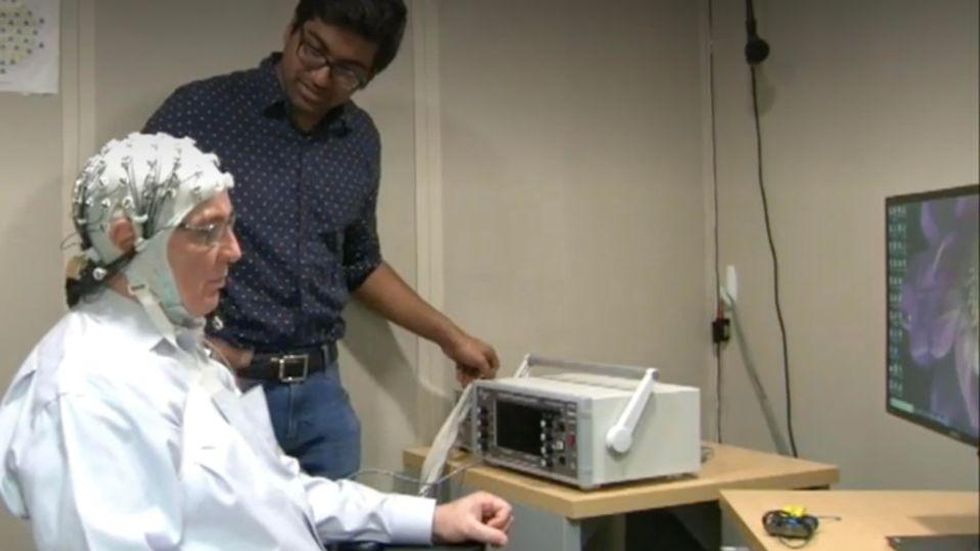
An older person participates in Robert Reinhart's research on brain stimulation.
Robert Reinhart
Reinhart’s subjects only suffered normal age-related memory deficits, but NIBS has great potential to help people with cognitive impairment and dementia, too, says Krista Lanctôt, the Bernick Chair of Geriatric Psychopharmacology at Sunnybrook Health Sciences Center in Toronto. Plus, “it is remarkably safe,” she says.
Lanctôt was the senior author on a meta-analysis of brain stimulation studies published last year on people with mild cognitive impairment or later stages of Alzheimer’s disease. The review concluded that magnetic stimulation to the brain significantly improved the research participants’ neuropsychiatric symptoms, such as apathy and depression. The stimulation also enhanced global cognition, which includes memory, attention, executive function and more.
This is the frontier of neuroscience.
The two main forms of NIBS – and many questions surrounding them
There are two types of NIBS. They differ based on whether electrical or magnetic stimulation is used to create the electric field, the type of device that delivers the electrical current and the strength of the current.
Transcranial Current Brain Stimulation (tES) is an umbrella term for a group of techniques using low-wattage electrical currents to manipulate activity in the brain. The current is delivered to the scalp or forehead via electrodes attached to a nylon elastic cap or rubber headband.
Variations include how the current is delivered—in an alternating pattern or in a constant, direct mode, for instance. Tweaking frequency, potency or target brain area can produce different effects as well. Reinhart’s 2022 study demonstrated that low or high frequencies and alternating currents were uniquely tied to either short-term or long-term memory improvements.
Sessions may be 20 minutes per day over the course of several days or two weeks. “[The subject] may feel a tingling, warming, poking or itching sensation,” says Reinhart, which typically goes away within a minute.
The other main approach to NIBS is Transcranial Magnetic Simulation (TMS). It involves the use of an electromagnetic coil that is held or placed against the forehead or scalp to activate nerve cells in the brain through short pulses. The stimulation is stronger than tES but similar to a magnetic resonance imaging (MRI) scan.
The subject may feel a slight knocking or tapping on the head during a 20-to-60-minute session. Scalp discomfort and headaches are reported by some; in very rare cases, a seizure can occur.
No head-to-head trials have been conducted yet to evaluate the differences and effectiveness between electrical and magnetic current stimulation, notes Lanctôt, who is also a professor of psychiatry and pharmacology at the University of Toronto. Although TMS was approved by the FDA in 2008 to treat major depression, both techniques are considered experimental for the purpose of cognitive enhancement.
“One attractive feature of tES is that it’s inexpensive—one-fifth the price of magnetic stimulation,” Reinhart notes.
Don’t confuse either of these procedures with the horrors of electroconvulsive therapy (ECT) in the 1950s and ‘60s. ECT is a more powerful, riskier procedure used only as a last resort in treating severe mental illness today.
Clinical studies on NIBS remain scarce. Standardized parameters and measures for testing have not been developed. The high heterogeneity among the many existing small NIBS studies makes it difficult to draw general conclusions. Few of the studies have been replicated and inconsistencies abound.
Scientists are still lacking so much fundamental knowledge about the brain and how it works, says Reinhart. “We don’t know how information is represented in the brain or how it’s carried forward in time. It’s more complex than physics.”
Lanctôt’s meta-analysis showed improvements in global cognition from delivering the magnetic form of the stimulation to people with Alzheimer’s, and this finding was replicated inan analysis in the Journal of Prevention of Alzheimer’s Disease this fall. Neither meta-analysis found clear evidence that applying the electrical currents, was helpful for Alzheimer’s subjects, but Lanctôt suggests this might be merely because the sample size for tES was smaller compared to the groups that received TMS.
At the same time, London neuroscientist Marco Sandrini, senior lecturer in psychology at the University of Roehampton, critically reviewed a series of studies on the effects of tES on episodic memory. Often declining with age, episodic memory relates to recalling a person’s own experiences from the past. Sandrini’s review concluded that delivering tES to the prefrontal or temporoparietal cortices of the brain might enhance episodic memory in older adults with Alzheimer’s disease and amnesiac mild cognitive impairment (the predementia phase of Alzheimer’s when people start to have symptoms).
Researchers readily tick off studies needed to explore, clarify and validate existing NIBS data. What is the optimal stimulus session frequency, spacing and duration? How intense should the stimulus be and where should it be targeted for what effect? How might genetics or degree of brain impairment affect responsiveness? Would adjunct medication or cognitive training boost positive results? Could administering the stimulus while someone sleeps expedite memory consolidation?
Using MRI or another brain scan along with computational modeling of the current flow, a clinician could create a treatment that is customized to each person’s brain.
While Sandrini’s review reported improvements induced by tES in the recall or recognition of words and images, there is no evidence it will translate into improvements in daily activities. This is another question that will require more research and testing, Sandrini notes.
Scientists are still lacking so much fundamental knowledge about the brain and how it works, says Reinhart. “We don’t know how information is represented in the brain or how it’s carried forward in time. It’s more complex than physics.”
Where the science is headed
Learning how to apply precision medicine to NIBS is the next focus in advancing this technology, says Shankar Tumati, a post-doctoral fellow working with Lanctôt.
There is great variability in each person’s brain anatomy—the thickness of the skull, the brain’s unique folds, the amount of cerebrospinal fluid. All of these structural differences impact how electrical or magnetic stimulation is distributed in the brain and ultimately the effects.
Using MRI or another brain scan along with computational modeling of the current flow, a clinician could create a treatment that is customized to each person’s brain, from where to put the electrodes to determining the exact dose and duration of stimulation needed to achieve lasting results, Sandrini says.
Above all, most neuroscientists say that largescale research studies over long periods of time are necessary to confirm the safety and durability of this therapy for the purpose of boosting memory. Short of that, there can be no FDA approval or medical regulation for this clinical use.
Lanctôt urges people to seek out clinical NIBS trials in their area if they want to see the science advance. “That is how we’ll find the answers,” she says, predicting it will be 5 to 10 years to develop each additional clinical application of NIBS. Ultimately, she predicts that reigning in Alzheimer’s disease and mild cognitive impairment will require a multi-pronged approach that includes lifestyle and medications, too.
Sandrini believes that scientific efforts should focus on preventing or delaying Alzheimer’s. “We need to start intervention earlier—as soon as people start to complain about forgetting things,” he says. “Changes in the brain start 10 years before [there is a problem]. Once Alzheimer’s develops, it is too late.”

